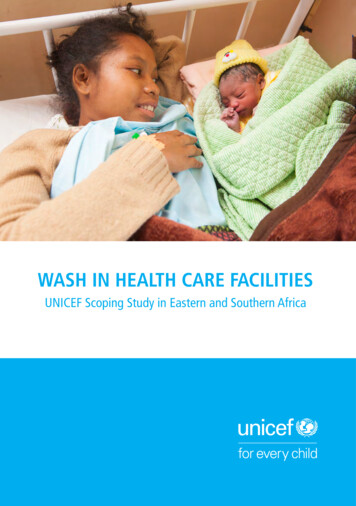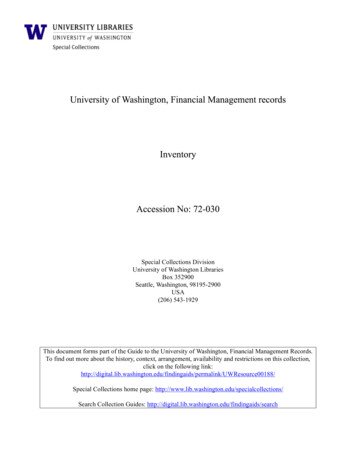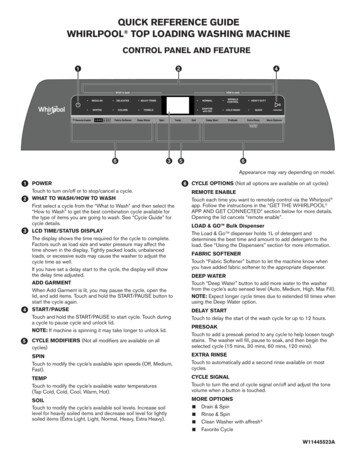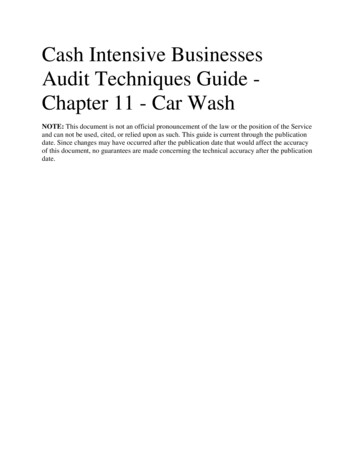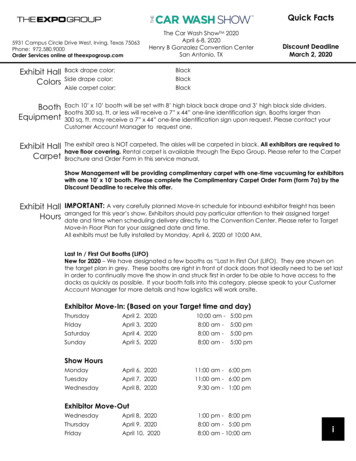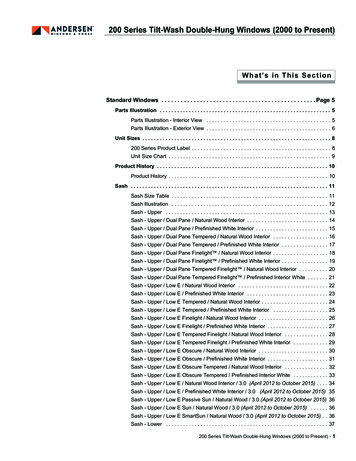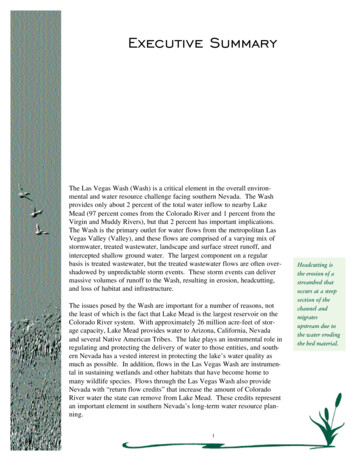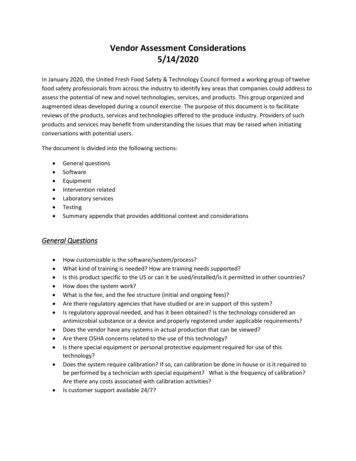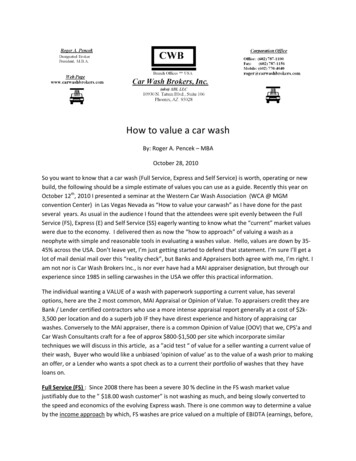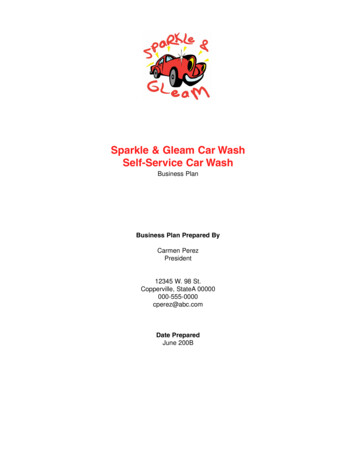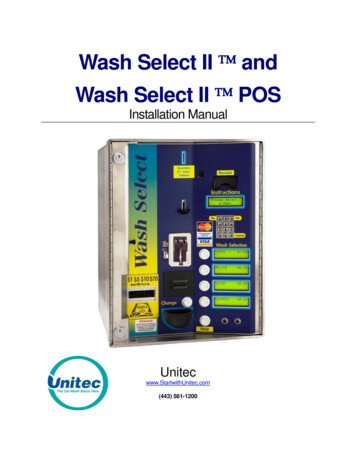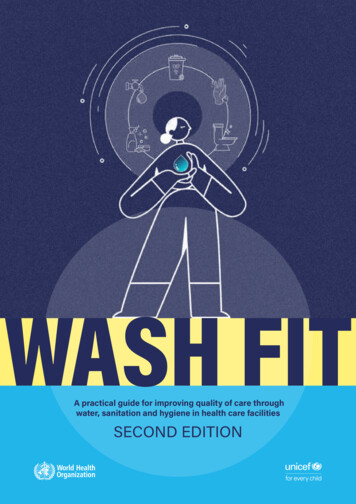
Transcription
WASH FITA practical guide for improving quality of care throughwater, sanitation and hygiene in health care facilitiesSECOND EDITION
WASH FITA practical guide for improving quality of care throughwater, sanitation and hygiene in health care facilitiesSECOND EDITION
Water and Sanitation for Health Facility Improvement Tool (WASH FIT): A practical guide for improving quality of care through water,sanitation and hygiene in health care facilities. Second edition.ISBN 978-92-4-004323-7 (electronic version)ISBN 978-92-4-004324-4 (print version) World Health Organization 2022Some rights reserved. This work is available under the Creative Commons Attribution-NonCommercial-ShareAlike 3.0 IGO licence (CC BYNC-SA 3.0 IGO; igo).Under the terms of this licence, you may copy, redistribute and adapt the work for non-commercial purposes, provided the work isappropriately cited, as indicated below. In any use of this work, there should be no suggestion that WHO endorses any specific organization,products or services. The use of the WHO logo is not permitted. If you adapt the work, then you must license your work under the sameor equivalent Creative Commons licence. If you create a translation of this work, you should add the following disclaimer along with thesuggested citation: “This translation was not created by the World Health Organization (WHO). WHO is not responsible for the content oraccuracy of this translation. The original English edition shall be the binding and authentic edition”.Any mediation relating to disputes arising under the licence shall be conducted in accordance with the mediation rules of the WorldIntellectual Property Organization ested citation. Water and Sanitation for Health Facility Improvement Tool (WASH FIT): a practical guide for improving quality of carethrough water, sanitation and hygiene in health care facilities, second edition. Geneva: World Health Organization; 2022. Licence: CC BYNC-SA 3.0 IGO.Cataloguing-in-Publication (CIP) data. CIP data are available at http://apps.who.int/iris.Sales, rights and licensing. To purchase WHO publications, see http://apps.who.int/bookorders. To submit requests for commercial useand queries on rights and licensing, see https://www.who.int/copyright.Third-party materials. If you wish to reuse material from this work that is attributed to a third party, such as tables, figures or images, it isyour responsibility to determine whether permission is needed for that reuse and to obtain permission from the copyright holder. The risk ofclaims resulting from infringement of any third-party-owned component in the work rests solely with the user.General disclaimers. The designations employed and the presentation of the material in this publication do not imply the expressionof any opinion whatsoever on the part of WHO concerning the legal status of any country, territory, city or area or of its authorities, orconcerning the delimitation of its frontiers or boundaries. Dotted and dashed lines on maps represent approximate border lines for whichthere may not yet be full agreement.The mention of specific companies or of certain manufacturers’ products does not imply that they are endorsed or recommended by WHOin preference to others of a similar nature that are not mentioned. Errors and omissions excepted, the names of proprietary products aredistinguished by initial capital letters.All reasonable precautions have been taken by WHO to verify the information contained in this publication. However, the published materialis being distributed without warranty of any kind, either expressed or implied. The responsibility for the interpretation and use of the materiallies with the reader. In no event shall WHO be liable for damages arising from its use.
CONTENTS35721Improving health actions andoutcomes using WASH FITThe WASH FIT process: from initialimplementation to national roll-out4Facility-level factors to makeWASH FIT a success81422iiiThe WASH FIT improvement cycle6Templates53References73Annex 1 Updates from the first edition 75Annex 2 WASH FIT indicators 76Annex 3 Adapting the WASH FIT assessment 82Annex 4 Calculating Joint MonitoringProgramme for Water Supply, Sanitationand Hygiene service ladders from theWASH FIT assessment 2784Annex 5 Suggested spot checks andtheir frequency 86Annex 6 Technical fact sheets 87Annex 7 Sanitary inspection forms 107Annex 8 Glossary of terms 117WASH FIT1Introduction
ACKNOWLEDGEMENTSThis document was written by Arabella Hayter, Maggie Montgomery, ClaireKilpatrick and Julie Storr (WHO), and Irene Amongin (UNICEF). Strategic directionwas provided by Bruce Gordon (WHO) and Silvia Gaya (UNICEF).ivWHO gratefully acknowledges the support of the following who contributedtechnical content and who reviewed the document: Janet Ausel, Food for theHungry, United States of America (USA); Anand Balachandran, WHO Headquarters;Aboubacar Ballo, Terre des hommes, Mali; Elmira Bacatan, UNICEF, the Philippines;Rod Beadle, Food for the Hungry, USA; Prakash Bohara, Terre des hommes, Nepal;John Brogan, Helvetas, Switzerland; Carlos Cornavalon, University of Sydney,Australia; Jennifer de France, WHO Headquarters; Tedbabe Degefie Hailegabriel,UNICEF, USA; Hassane Dembele, Terre des hommes, Mali; Indah Deviyanti, WHO,Indonesia; Shinee Enkhtsetseg, WHO European Centre for Environment and Health,Germany; Joanna Esteves Mill, WHO Headquarters; Karin Geffert, WHO EuropeanCentre for Environment and Health, Germany; Jose Gesti Canuto, independentconsultant, Spain; Faustina Gomez, WHO, India; Chelsea Huggett, WaterAid,Australia; Jacob Nkwan Gobte, Infection Control Africa Network, Cameroon;Valentina Grossi, WHO European Centre for Environment and Health, Germany;Sean Kearney, International Association of Plumbing and Mechanical Officials,Ireland; Laxman Kharal Chettry, Terre des hommes, Nepal; Oyuntogos Lkhasuren,WHO, Lao People’s Democratic Republic; Bonifacio Magtibay, WHO, the Philippines;Andrea Martinsen, United States Centers for Disease Control and Prevention,USA; Rory McKeown, WHO Headquarters; Kate Medlicott, WHO Headquarters;Nana Mensah Abrampah, WHO Headquarters; Mundia Mutukwa, World Vision,Zambia; Desiree Raquel Narvaez, UNICEF, USA; Pierre Yves Oger, UNICEF, USA;Molly Patrick, United States Centers for Disease Control and Prevention, USA;Genandraline Peralta, WHO, the Philippines; Ute Pieper, independent consultant,Germany; Anangu Rajasingham, United States Centers for Disease Control andPrevention, USA; Nabin Rana Magar, Terre des hommes, Nepal; Hussein Rasheed,WHO, India; Angella Rinehold, WHO Headquarters; Carrie Ripkey, United StatesCenters for Disease Control and Prevention, USA; Isaac Samunete, World Vision,Zambia; Oliver Schmoll, WHO European Centre for Environment and Health,Germany; Noor Siddiquee, HEKS, Bangladesh; Abheet Solomon, UNICEF, USA;Viphada Sounvoravong, WHO, Lao People’s Democratic Republic; Grant Stewart,International Association of Plumbing and Mechanical Officials, Australia; RuthStringer, Health Care Without Harm, United Kingdom of Great Britain and NorthernIreland; Souvanaly Thammavong, WHO, Lao People’s Democratic Republic;Phetsamone Thavonesouk, WHO, Lao People’s Democratic Republic; Nghia Ton,WHO, Viet Nam; Victoria Trinies, United States Centers for Disease Control andPrevention, USA; Elena Villalobos Prats, WHO Headquarters.WASH FITWHO and UNICEF gratefully acknowledge the financial support provided by:Agence Francaise de Developpement (AFD); Australian Department of ForeignAffairs and Trade (DFAT); Conrad N. Hilton Foundation; Luxembourg DevelopmentCooperation; Netherlands Directorate-General for International Cooperation(DGIS); United Kingdom Foreign Commonwealth & Development Office (FCDO);New Venture Fund/Water 2020.
LIST OF ABBREVIATIONSgender equality, disability and social inclusionHCWMhealth care waste managementIPCinfection prevention and controlLDCleast developed countryNGOnongovernmental organizationPPEpersonal protective equipmentQIquality improvementSIsanitary inspectionSOPstandard operating procedureUNUnited NationsUNICEFUnited Nations Children’s FundWASHwater, sanitation and hygieneWASH FITWater and Sanitation for Health Facility Improvement ToolWHOWorld Health OrganizationvWASH FITGEDSI
INTRODUCTION1Introduction
1.1 BACKGROUNDFully functioning water, sanitation, hygiene (WASH) and health care wastemanagement services are a critical aspect of infection prevention and control (IPC)practices, and ensuring patient safety and quality of care. Such services are alsoessential for creating an environment that supports the dignity and human rightsof all care seekers, especially mothers, newborns, children and care providers.WASH and waste services are also critical for preventing and effectively respondingto disease outbreaks. The COVID-19 pandemic has exposed gaps in these basicservices (Box 1). These gaps threaten the safety of patients and caregivers, and haveenvironmental consequences, especially as a result of large increases in plastichealth care waste. In short, WASH is a critical foundation for improving qualityacross the health system (1).Many facilities lack plans and budgets for WASH, which has impacts on IPC. Thislack of services, and of systems to improve them, compromises the ability to providesafe and quality care, and places health care providers and those seeking care atsubstantial risk of infection and loss of dignity. Unhygienic health care facilitieswithout drinking water or functional toilets are also a disincentive to seeking careand undermine staff morale – these factors can have a critical impact on controllinginfectious disease outbreaks.Climate change and its impacts on WASH and health services, gender-specificneeds, and equity in service provision and management all require rigorousattention, adaptable tools and regular monitoring.Box 1. Global status of WASH services in health care facilities2One third of health care facilities do not have what is needed to clean hands wherecare is provided. One in four facilities lack basic water services, and one in 10 have nosanitation services.Around 1.8 billion people use facilities that lack basic water services, and 800 million usefacilities with no toilets.Across the world’s 47 least developed countries, the problem is even greater: half of healthcare facilities lack basic water services. The extent of the problem in these countries is notfully known because of major gaps in data, especially on environmental cleaning (2).WASH SERVICES IN HEALTH CARE FACILITIES OF LEAST DEVELOPED COUNTRIES (2019)BASICWATERBASICSANITATIONHAND HYGIENEAT POINTSOF CAREBASIC HEALTHCARE SH FITIN LDCS50% 37% 74% 30%INSUFFICIENTDATA
The 2018 global call to action on WASH in health care facilities by the UnitedNations (UN) Secretary-General elevated this issue among all UN agencies,partners and Member States. Building on the global call, all 194 World HealthOrganization (WHO) Member States approved a resolution on WASH in health carefacilities at the 2019 World Health Assembly (3). The resolution calls on countries toestablish baselines and set targets, embed WASH in key health programmes andbudgets, improve and maintain infrastructure, and regularly report on progress.WHO and the United Nations Children’s Fund (UNICEF), along with more than50 partners, have committed to supporting countries in implementing the resolution.Alongside the resolution, WHO and UNICEF published a set of eight practical stepsfor improving and sustaining WASH services and practices in health care facilities(4). Step 4 (“Improve and maintain infrastructure”) includes use of the Water andSanitation for Health Facility Improvement Tool (WASH FIT) and other risk-basedimprovement tools. As of 2022, of the 65 countries reporting progress in implementingthe World Health Assembly resolution, half are undertaking infrastructureimprovements, through WASH FIT or other improvement programmes (see Fig. 1).Fig. 1. Linkages between WASH FIT, global monitoring indicators and national actions to improve WASH inhealth care facilitiesIPC core componentsAntimicrobial resistancenational action plansQuality of care for mothersand newbornsEmergency preparednessand responseVaccinesGlobal and nationalmonitoring of SustainableDevelopment Goal 6(safe velopmentDatamonitoringand reviewInfrastructureimprovementsNationalstandards andaccountabilitymechanismsNationaltargets androadmapSituationanalysis andassessmentNATIONAL ACTIONSAND LEADERSHIP“PRACTICAL STEPS”WASH FIT implementationWASH FITIntegration with healthOperationalresearch andlearning
1.2 CONTENT AND PURPOSEWASH FIT is a risk-based management tool for health care facilities, covering keyaspects of WASH services: water; sanitation; hand hygiene; environmental cleaning;health care waste management; and selected aspects of energy, building andfacility management.WASH FIT: provides a framework to develop, monitor and continuously implement animprovement plan (covering infrastructure, behaviours, and operation andmaintenance) and prioritize specific WASH actions that are climate-resilient,equitable and inclusive (Fig. 2); guides planning and implementation of WASH improvements as part of widerquality improvement (QI) efforts, and to meet local, national and global standards; supports the implementation of IPC standard and transmission-basedprecautions according to national guidelines and standard operating procedures(SOPs); and facilitates multisectoral actions by bringing together all those who shareresponsibility for providing WASH services, including legislators and policymakers, district1 health officers, hospital administrators, water and sanitationengineers, climate and environmental specialists, and users.Fig. 2. Overview of WASH STABLISH & TRAINTHE TEAM; DOCUMENTDECISION MAKINGMONITOR, REVIEW,ADAPT, IMPROVEDEVELOP ANIMPROVEMENT PLANAND TAKE ACTION23ASSESSTHE FACILITYIDENTIFY ANDPRIORITZE AREASFOR IMPROVEMENTHumanCivil societyengagementIntersectoralcollaboration:energy andclimate, healthOUTCOMESbImproved infrastructure, services and facility managementImproved staffmorale andperformanceIncreased careseekingImproved IPC andreduced AMRLess environmentalpollution from safer,more sustainablesolid and liquidwaste managementMore efficientuse ofresources andlower healthcare costsIMMEDIATE AND LONG-TERM IMPACTScQuality, equity and dignityDignified, safe pregnancy anddelivery and fewer preventablematernal and newborn deathsaWASH FITbc1.Healthier, more productivefamilies and communitiesImproved outbreak responseand resilience and healthworker safetyAMR: antimicrobial resistanceINPUTS: political, financial and material, human and community resources that go into conducting the WASH FIT assessment anddeveloping and implementing a facility-based improvement planOUTCOMES: direct changes that could occur from the use of WASH FIT, such as infrastructure changes, operational changes,improved cleaning and hand hygiene practices, and resilience to climate change.IMPACTS: broader and longer-term changes, beyond the direct changes to the health care facility, resulting from improving WASHservices and hygiene practices.“District” is taken to mean any clearly defined administrative area where local government and administrative structure take onresponsibilities from the national government. The nature of a district may vary from country to country.
As of early 2022, WASH FIT has been used in more than 40 countries2 across allcontinents, primarily in small, primary care health facilities in low-resource settings.These efforts have ranged in scale and duration, from relatively small-scale effortsled by implementing partners in a few facilities to government-led national efforts,where WASH FIT processes are embedded in health systems monitoring and QIefforts. WHO and UNICEF are working to better understand how WASH FIT is beingused and the outcomes of its implementation (see Box 2).This is the second edition of the WASH FIT guide. It includes new guidance on thenational- and facility-level processes for success, updated tools, and a set of factsheets for addressing safely managed water and sanitation services, hand hygieneand health care waste. Throughout the second edition, there is also a greateremphasis on climate change and gender equality. The guide is accompanied by atraining manual and set of training slides.Box 2. The learning agenda: evaluating and improving WASH FITCountries, organizations, facility staff and individuals starting to use WASH FIT maybenefit from learning about others’ experiences. For this reason, WHO and UNICEF arecollecting information on where and how the tool is being used. If you have used WASHFIT and would like to share your experience, please visit www.washinhcf.org/wash-fit.Updates and news related to WASH FIT, and WASH in health care facilities moregenerally, is shared through the regular WHO and UNICEF WASH in health care facilitiesnewsletter. To sign up for future editions, visit www.washinhcf.org.1.3 TARGET AUDIENCE5Table 1 summarizes the target audiences for this guide.Table 1. Target audiences for the WASH FIT guideTypical areas of responsibilityQI teams, WASH and IPC focal points, community WASH andhealth committees and technical staff (engineers, inspectors,plumbers), WASH FIT team leadersUndertaking assessments, identifying areas for improvement,and ensuring that improvements are acted upon and WASHFIT is sustained over timeHealth care facility managers and other senior managersOverseeing essential health care facility functions (e.g. budgeting)Local/district government officials and health officesPlanning, supervising and undertaking budget allocationsNational health policy-makers (e.g. ministries of health) andhealth regulatorsMonitoring progress nationally and at a subnational level,developing relevant policies and standardsInfrastructure and WASH financing officialsPrioritizing resources, investments and budgetsWASH and health nongovernmental organizations, civil societyand other partners supporting or leading implementation,evaluation and programme planningSupporting facility staff to assess and identify areas forimprovement, advocating for more funding for facilities andsupporting government prioritiesEnvironment and climate specialists, planners and advocatesDeveloping national and local sustainability plans, andmeeting global and national climate and sustainability targetsWASH FITAudience2.For a list of countries, visit www.washinhcf.org/wash-fit.
1.4 STRUCTURE OF THIS GUIDE ANDSUPPORTING RESOURCESThis guide (Fig. 3) provides practical step-by-step guidance on adapting and usingWASH FIT in a range of contexts. Section 2 describes how WASH FIT can be integrated with quality of care,IPC and maternal child health efforts, and how the sustainability and climateresilience of WASH services can be improved. Section 3 describes the WASH FIT process, from training and initialimplementation to scale-up, and the financing and investments needed toimprove and maintain WASH services. Section 4 describes some of the factors for success needed at the local andfacility levels, including staff and community involvement, and the role of seniorleadership. Section 5 details the five-step WASH FIT improvement cycle for facilities toassess, maintain and improve services over time. Section 6 provides a set of tools and templates to support the five-step cycle. Annexes 1–7 include guidance on using and adapting the assessment tool,a set of sanitary inspection forms to assess a facility’s water supply andtechnical fact sheets.The guide is accompanied by: a training package, consisting of a trainingmanual and a set of MS PowerPoint modules with trainer notes and participatoryexercises, as well as further reading around preparation, delivery and evaluation oftraining, which can be adapted to the local context;3 and an assessment form andsupporting tools.6Fig. 3 WASH FIT packageREAD THIS FIRSTTemplatesAssessment, hazard and risk analysis tools (support development andimplementation of improvemnt plan and ongoing monitoring)Fact sheets5 fact sheets (within the WASH FIT Practical Guide)3-5 pages5-minute read eachWASH FIT manual for trainersAll the materials for training in one place (slides,speaker notes, assessment & evaluation tools,sample agenda etc.)30-minutereadWASH FIT portalWASH FITWASH FIT SECOND ED.PRACTICAL GUIDESTEP-BY-STEP GUIDANCE100 pages50-minute read3.Visit www.washinhcf.org/wash-fit for the latest versions.www.washinhcf.org/washfit Country examples, casestudies and opportunity toshare experience WASH FIThelpdesk washinhcf@who.int
1.5 PURPOSE AND SCOPE OF WASH FITWASH FIT is an iterative QI methodology to improve WASH services. Its ultimateaim is to improve the quality of care and health outcomes through fewer infections,greater uptake of services, and more productive and confident health care staff (seeFig. 2). The approach to QI consists of an analysis of process and outcomes data,and systematic efforts to improve performance (5). It involves every person workingto implement iterative, measurable changes to make health services more effective,safe and people centred (1).WASH FIT involves a continuous process of conducting assessments and spotchecks, understanding how gaps in WASH infrastructure and practices may beaffecting quality of care, designing an improvement plan to address these gaps,and modifying the improvement plan based on ongoing monitoring and evaluation.It may be more valuable to integrate WASH FIT into existing quality tools andprocesses rather than to implement WASH FIT separately.7WASH FIT“I thought the way WASH services were managed and the hygiene practicespassed on to me by previous health workers from [the facility] were acceptable,and that improvements were not needed or too much effort. But after doing steps 1and 2 (setting up the team, conducting the assessment), collectively we identifiedmany items that need improving [such as de-clogging drains, increasing ventilationand staff training for waste management]. These are things we can do ourselvesthat benefit the staff and the clientele we are serving. The time will come for meto be transferred to another facility, I can hand over the facility to the next healthworker together with the WASH FIT plan with the overall rating, that he/she canuse as the baseline for further improvement.”Nurse, WASH FIT pilot health centre, Northern Manila, the Philippines, 2019
WASH FITIMPROVINGHEALTH ACTIONSAND OUTCOMESUSING WASH FIT2Improving health actions and outcomes using WASH FIT1 Introduction
2.1 ENVIRONMENTAL SUSTAINABILITY ANDCLIMATE RESILIENCEWith growing health threats associated with climate change and environmentaldegradation, all health care facilities need to implement measures to strengthen theresilience and improve the sustainability of their WASH and energy services. Indeed,at the 26th UN Climate Change Conference of the Parties in 2021, 52 countriescommitted to implementing low-carbon, sustainable health systems.Health care facilities provide services and care to people harmed by extremeweather events and long-term climate hazards. New infrastructure should bedesigned and operated to ensure continuity of services when they are needed mostand with minimal negative impact on the environment. Over time, such adaptationssave costs, support effective resource use, and limit environmental waste andcontamination (e.g. by carbon emissions; persistent organic pollutants; chemicalcontaminants in air, water and soil).The WHO guidance for climate-resilient and environmentally sustainable health carefacilities sets out four fundamental requirements for providing safe and quality care(Fig. 4). One of these is sustainable and safe management of water, sanitation and healthcare waste services (6). The WASH FIT methodology takes into account elements of thisguidance, including indicators that can be systematically monitored and improved tostrengthen adaptation and resilience. WASH systems that are informed by climate riskassessments will be more resilient and are more likely to withstand shocks and stresses.Referring to existing regional climate vulnerability assessments may be useful.A climate-resilient health system is one that is “capable to anticipate, respond to,cope with, recover from and adapt to climate-related shocks and stress, so as tobring sustained improvements in population health, despite an unstable climate”. (7)9Examples of interventions and improvements that facilities can make to strengthenclimate resilience are provided in Technical fact sheet 1. The UNICEF strategicframework for WASH climate-resilient development provides further information onthe main elements to be considered in planning and undertaking actions aimed atbuilding climate-resilient WASH services (8).WASH FITFig. 4. Framework for building climate-resilient and environmentally sustainable health care facilitiesSource: Adapted from WHO (6).
Investment in healthier environments provides protection against future disastersand offers some of the best economic and social returns for communities. The WHOmanifesto for a healthy recovery from COVID-19 sets out six key prescriptions,including investing in water, sanitation and clean energy in health care facilities(9). In both the ongoing response to the COVID-19 pandemic and preparingfor future epidemics, all policies, procurement and resourcing should invest inactions that protect human health, and minimize environmental degradation andclimate impacts. Reducing packaging and using more environmentally sustainablepackaging, effectively segregating wastes, reducing unnecessary use of gloves andstrengthening hand hygiene are examples of such measures.2.2 GENDER EQUALITY, DISABILITY ANDSOCIAL INCLUSION10The design and management of WASH services in health care facilities must considera variety of user needs. Users include women in labour and menstruating women;infants and children; older people; people with disabilities; individuals with particularreligious or cultural practices and beliefs; and people experiencing injury, illness orincontinence. Women are a particularly important and common user group. Theyform 70% of the global health workforce, comprising the vast majority of frontlinenurses, midwives and cleaning staff (10). Female patients and staff may face negativeimpacts of cultural taboos around menstruation and post-birth bleeding. In mostcultures, they also have socially prescribed roles as stewards of water and carers forfamily members; as a result, they are particularly exposed to risk of infection frompoor hygiene. They may experience risks to personal safety and security when usingWASH in the workplace or as users of health care facilities. The planning, designand management of WASH services in health care facilities must therefore considerthe accessibility, safety, privacy, social appropriateness or acceptability, and comfortof these many different users. WASH FIT includes indicators that address issues ofgender equality, disability and social inclusion (GEDSI), and guidance to make theWASH FIT process inclusive and equitable (see Technical fact sheet 2).2.3 EMERGENCIES AND PANDEMICPREPAREDNESSThe COVID-19 pandemic has highlighted that many health systems around theworld are underprepared and unable to deliver basic services, rendering themunable to respond to disease outbreaks and deliver quality care.WASH FITWASH FIT provides a framework for facilities to meet the requirements for basicservices and thereby strengthen preparedness and response capacities for epidemicsand pandemics. Existing WHO guidance on the safe management of drinking water,sanitation and health care waste, and recommendations on hand hygiene, all apply toCOVID-19. No additional or different measures are needed (11). In emergency settings,users may wish to simplify the assessment form to focus on a smaller set of priorityissues. Alternatively, additional indicators relevant to the emergency or outbreak could beadded. For example, in Mali, indicators agreed by the national COVID-19 taskforce wereintegrated into the WASH FIT assessment. Guidance on how to do this is in Annex 3.Emergencies can lead to large increases in numbers of users of health care facilities,and infectious diseases may change how care is delivered. COVID-19 testing,treatment and vaccinations have led to increases in the volume of health care wastein many countries and facilities, overloading limited waste management systems andnegatively affecting the environment (12). Technical fact sheet 4 describes specificmeasures to reduce, recycle, and more safely and sustainably treat health care waste.
2.4 INFECTION PREVENTION AND CONTROLWHO IPC resources and normative guidance on IPC (13-15) emphasize WASH at thehealth care facility level as both a core component and a minimum requirement forachieving strong and effective IPC programmes. Associated WHO IPC assessmenttools and implementation guides are available (16-18). These tools generate valuablecomplementary data on WASH that, if available, should feed into the WASH FITcycle. Technical fact sheet 5 provides guidance on how to apply the hand hygienemultimodal improvement strategy within WASH FIT.2.5 QUALITY OF CAREQuality of care is the degree to which health services for individuals andpopulations increase the likelihood of desired health outcomes. WASH servicesand practices are fundamental to delivering quality of care and are especiallyimportant during childbirth. As outlined in WHO maternal and newborn standards,WASH is necessary not only for IPC but for preserving dignity and respect, andproviding a supportive environment (19, 20). WASH indicators
WASH FIT iii CONTENTS Annex 1 Updates from the first edition 75 Annex 2 WASH FIT indicators 76 Annex 3 Adapting the WASH FIT assessment 82 Annex 4 Calculating Joint Monitoring Programme for Water Supply, Sanitation and Hygiene service ladders from the WASH FIT assessment 84 Annex 5 Suggested spot checks and their frequency 86 Annex 6 Technical fact sheets 87
